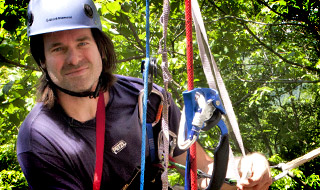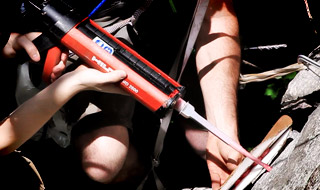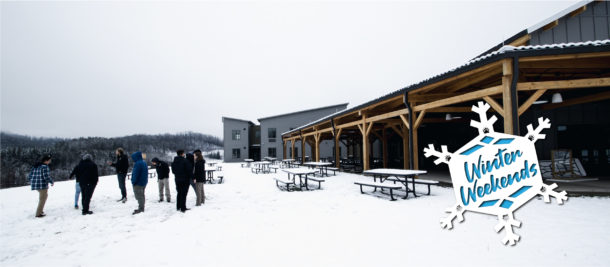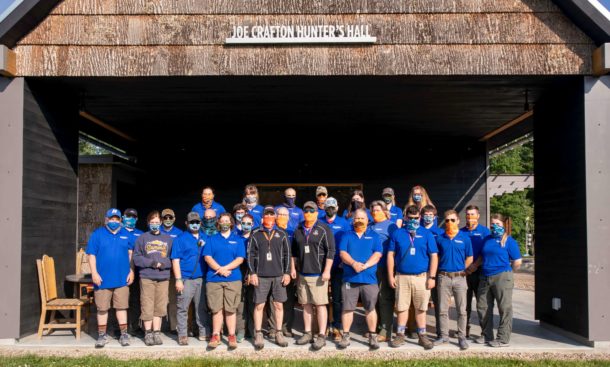
There are plenty of climbs in the New River Gorge in need of a little TLC and it’s no surprise. Most were established well before many of the Scouts reading this were born.
Old routes mean bolts and hardware, which keep climbers on the rock and off the ground, are often worn out. So who gets to bust the rust when they need to be replaced?
Enter Venture Crew 5.14 from Pennsylvania.
Composed entirely of rock-loving Scouts, the crew came to the NRG to help out during an annual climbing festival called the New River Rendezvous. The “’Vous” is held to raise money for the New River Alliance of Climbers (NRAC), which is charged with the upkeep of the majority of the permanent hardware in the gorge.
[pullquote]“I want people to come here, have a good time and want to come back.” — Kenny Parker, co-owner of Waterstone Outdoors and vice president of NRAC [/pullquote]
And who better to give Crew 5.14 a hand than Kenny Parker, the vice president of NRAC and co-owner of the New River Gorge’s prominent climbing shop, Waterstone Outdoors.
As an influential climber for over 25 years, Parker has seen his share of rock and placed his share of hardware. Parker has shifted his focus, though, from developing new routes to replacing the aging gear on older ones.
“In the old days we would just go to the hardware store and get any expansion bolts we could find,” Parker said. “I’m responsible for a lot of the old ones. I did a lot of new routes here.”
To get a first-hand look at some anchors that need work, share this post with your friends.
According to Parker, it’s impossible to gauge the strength of the old hardware, but, with a hodgepodge of gear subject to unknown amounts of wear, it’s likely much of the old equipment has outlived its usefulness.
“The main reason you’re doing it is safety,” said Parker. “If you have people falling and dying, it jeopardizes climbing.”
Whether selling the right gear at Waterstone or actually replacing bolts, Parker hopes he is helping create a place where climbers can come and enjoy their passion safely.
“I own a shop here. The better the climbing situation here, the better the business,” said Parker. “I want people to come here, have a good time and want to come back.”
How NRAC Does It


Even though the folks at NRAC are seasoned, bolt-changing veterans, there is still a lot of work involved in updating the hardware. Prior to completing any bolt removal or installation in the park, you must obtained a permit from the National Park Service for the work.
Then, before the work begins, climbers have to report old bolts that need considered for replacement. This could be anyone from Parker to a concerned climber stopping by Waterstone Outdoors.
After the hardware in question is evaluated, NRAC decides whether the bolt needs to be replaced or not.
While every situation is different, replacing the bolts on a climb might look like this:
- Rappel to the questionable hardware and make sure you are secure.
- Connect to the pre-existing hardware by clipping into the old bolt. This means attaching your harness to the bolt with a runner or piece of webbing.
- Analyze the clipping positions and rock quality near the old bolt or pin and decide on a new bolt location. This is important to make sure the climb is still safe after the new hardware is added.
- Drill an appropriate hole using either a power or hand drill.
- Put in the new bolt by either hammering and tightening it with a ratchet or gluing it in.
- Connect your harness to the new bolt and disconnect from the old hardware.
- Use a breaker bar to tighten the old bolt until it breaks off or use a hammer to loosen a pin until it can be pulled free.
- Patch the old bolthole with material like plumber’s putty.
- Most importantly, make sure you have the proper safety gear.
“If everything goes smooth, you can rebolt a sport route of 8 bolts in half a day,” Parker explained.
Amazingly, the NRAC crew that takes the time to re-equip all of these routes is entirely volunteer driven. Local climbers, guides, gear shop owners and now Venturers have all worked toward a safer and more enjoyable rock climbing experience in the New River Gorge.
“[NRAC] is all people volunteering to work because they care. They care about climbing and the area,” Parker said. “It’s not just a small group of people. NRAC is all the climbers. Hopefully, it will include these Boy Scouts.”
Like to climb? Tell us what you think.
Be sure to come back for Part 2 and Part 3 of this Adventures In Service series.



